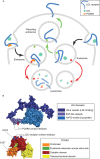The discovery of PCSK9 inhibitors: A tale of creativity and multifaceted translational research
- PMID: 24749106
- PMCID: PMC3991204
- DOI: 10.5339/gcsp.2013.39
The discovery of PCSK9 inhibitors: A tale of creativity and multifaceted translational research
Figures






Similar articles
-
PCSK9 Mutations in Familial Hypercholesterolemia: from a Groundbreaking Discovery to Anti-PCSK9 Therapies.Curr Atheroscler Rep. 2017 Oct 17;19(12):49. doi: 10.1007/s11883-017-0684-8. Curr Atheroscler Rep. 2017. PMID: 29038906 Review.
-
Proprotein convertase subtilisin/kexin type 9 (PCSK9) inhibitors: Present perspectives and future horizons.Nutr Metab Cardiovasc Dis. 2016 Oct;26(10):853-62. doi: 10.1016/j.numecd.2016.05.006. Epub 2016 May 30. Nutr Metab Cardiovasc Dis. 2016. PMID: 27352986 Review.
-
Proprotein convertase subtilisin/kexin type 9 (PCSK9): A potential multifaceted player in cancer.Biochim Biophys Acta Rev Cancer. 2021 Aug;1876(1):188581. doi: 10.1016/j.bbcan.2021.188581. Epub 2021 Jun 16. Biochim Biophys Acta Rev Cancer. 2021. PMID: 34144130 Review.
-
A tale of two patients: Levodopa and creative awakening in parkinson's disease - A qualitative report.Asian J Psychiatr. 2019 Jun;43:179-181. doi: 10.1016/j.ajp.2019.06.002. Epub 2019 Jun 13. Asian J Psychiatr. 2019. PMID: 31212166
-
PCSK9 inhibition for the treatment of hypercholesterolemia: promises and emerging challenges.Vascul Pharmacol. 2014 Aug;62(2):103-11. doi: 10.1016/j.vph.2014.05.011. Epub 2014 Jun 9. Vascul Pharmacol. 2014. PMID: 24924410 Review.
Cited by
-
PCSK 9 Inhibitors: A Short History and a New Era of Lipid-lowering Therapy.Heart Views. 2019 Apr-Jun;20(2):74-75. doi: 10.4103/HEARTVIEWS.HEARTVIEWS_59_19. Heart Views. 2019. PMID: 31462965 Free PMC article. No abstract available.
-
FOURIER & PCSK9 RNAi: Towards enhancing durability and efficacy of PCSK9 inhibitors.Glob Cardiol Sci Pract. 2017 Jun 30;2017(2):13. doi: 10.21542/gcsp.2017.13. Glob Cardiol Sci Pract. 2017. PMID: 29644225 Free PMC article. No abstract available.
-
Is there an increased cardiovascular risk in metabolically healthy obese individuals? Lessons from the HUNT (Nord-Trøndelag Health) study.Glob Cardiol Sci Pract. 2014 Jun 18;2014(2):44-7. doi: 10.5339/gcsp.2014.24. eCollection 2014. Glob Cardiol Sci Pract. 2014. PMID: 25405177 Free PMC article.
-
OSLER and ODYSSEY LONG TERM: PCSK9 inhibitors on the right track of reducing cardiovascular events.Glob Cardiol Sci Pract. 2015 Jun 26;2015(2):20. doi: 10.5339/gcsp.2015.20. eCollection 2015. Glob Cardiol Sci Pract. 2015. PMID: 26566525 Free PMC article.
-
Hypercholesterolemia: a literature review on management using tafolecimab: a novel member of PCSK9 monoclonal antibodies.Ann Med Surg (Lond). 2024 Mar 12;86(5):2818-2827. doi: 10.1097/MS9.0000000000001945. eCollection 2024 May. Ann Med Surg (Lond). 2024. PMID: 38694324 Free PMC article. Review.
References
-
- Hall J, Dib N. The path from pre-clinical research to FDA approval. J Cardiovasc Transl Res. 2008;1(2):93–94. - PubMed
-
- Kannel WB, Dawber TR, Friedman GD, Glennon WE, McNamara PM. Risk factors in coronary heart disease. An evaluation of several serum lipids as predictors of coronary heart disease; the framingham study. Ann Intern Med. 1964;61:888–899. - PubMed
-
- Kannel WB, Castelli WP, McNamara PM. Serum lipid fractions and risk of coronary heart disease. The Framingham study. Minn Med. 1969;52:1225–1230. - PubMed
-
- Hovingh GK, Davidson MH, Kastelein JJP, O'Connor AM. Diagnosis and treatment of familial hypercholesterolaemia. Eur Heart J. 2013;34(13):962–971. - PubMed
LinkOut - more resources
Full Text Sources
Other Literature Sources
Miscellaneous
